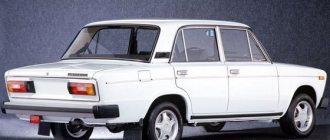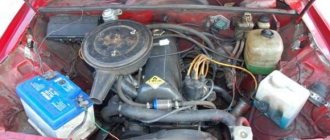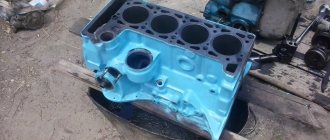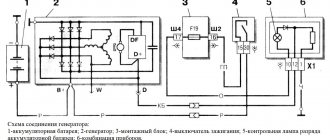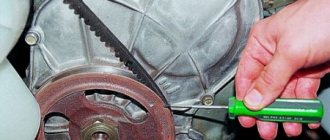Braking distance of a VAZ 2107 car with a permissible maximum weight during emergency braking from a speed of 80 km/h, no more than, m PARAMETERS VALUE Year of production of engines of this type 1972 - our time Power system Injector/carburetor Engine type Inline Number of pistons 4 Cylinder block material cast iron Cylinder head material aluminum Number of valves per cylinder 2 Piston stroke 8 0 mm Cylinder diameter 76 mm Engine capacity 1452 cm 3Power 71 l. With. at 5600 rpm. Maximum torque 104 Nm at 3600 rpm. Compression ratio 8.5 units Oil volume in crankcase 3.74 l
This engine uses AI-93 fuel. In practice, motorists can fill in completely different fuels. The most common deviations from the norm are the flooding of AI-92 and AI-95. You can read more about this below.
Its dimensions (characteristics are indicated in millimeters):
| Height | Width | Length |
| 665 | 541 | 565 |
What engine can be installed on this car?
Initially, 2 types of engines were installed on the VAZ 2107 model, these are:
- VAZ 2103, with a working volume of 1.5 liters
- VAZ 2106, with a working volume of 1.6 liters
Let's look at them next.
There were also 1.3 L and 1.2 L engines, but they are very few in number and practically never found.
It is also possible to install an engine from a VAZ with front-wheel drive, but it is too labor-intensive and unjustified.
This is interesting! Sometimes the English letter “i” is added before the name of the car. This means that the VAZ 2107 engine is an injector.
Injector – fuel sprayer. Nozzle. The principle of operation of injection gasoline engines is very similar to diesel engines.
Numbering of cylinders in different types of internal combustion engines
As for the standards for numbering combustion chambers, there are none. The way they are numbered in the internal combustion engine is influenced by the following factors:
- Type of drive;
- ICE type, block layout;
- Transverse or longitudinal arrangement of the unit under the hood;
- Side of rotation.
On standard front-wheel drive cars with a transversely mounted engine, the numbering begins on the timing side. So, near the timing belt there is the first cylinder and then all the others. The latter is located near the checkpoint.
Article on the topic: How to check a car for arrest, bail
Examples
In multi-cylinder V-twin engines, the first cylinder is located in the bank on the driver's side.
Engine VAZ 2103
Specifications
The main characteristics of the engine are presented in the table below:
| OPTIONS | MEANING |
| Year of production of engines of this type | 1972 – our time |
| Supply system | Injector/carburetor |
| engine's type | Row |
| Number of pistons | 4 |
| Cylinder block material | cast iron |
| Cylinder head material | aluminum |
| Number of valves per cylinder | 2 |
| Piston stroke | 80 mm |
| Cylinder diameter | 76 mm |
| Engine capacity | 1452 cm 3 |
| Power | 71 l. With. at 5600 rpm. |
| Maximum torque | 104 Nm at 3600 rpm. |
| Compression ratio | 8.5 units |
| Oil volume in crankcase | 3.74 l |
This engine uses AI-93 fuel. In practice, motorists can fill in completely different fuels. The most common deviations from the norm are the flooding of AI-92 and AI-95. You can read more about this below.
- According to available data, fuel consumption in urban conditions is 9.4 liters per 100 km.
- On a flat road at cruising speed it will already be 6.9 liters per 100 km.
- In mixed mode, consumption will be from 8 to 9 liters per 100 km. Such figures do not allow us to call this engine economical, but in this case a lot depends on the driver himself.
- Another parameter that depends on the driver is oil consumption per 100 km. For the average driver of a car with this engine, it is 700 g per 100 km. This, of course, is not small, but with careful driving you can reduce this consumption down to 450-500 g/100 km.
- The weight of the 2103 engine when fully assembled is 121 kg.
Its dimensions (characteristics are indicated in millimeters):
| Height | Width | Length |
| 665 | 541 | 565 |
Cylinder numbering in the most common types of vehicles
Unfortunately, there are no generally accepted rules for numbering cylinders in automobile engines - each automaker uses its own system, which often differs even for different engines of the same automaker. Therefore, the most authoritative source for you in this matter should be the repair and operation manual for your specific car, or, in the absence of one, the knowledge of car repair professionals.
In inline 4 and 6 cylinder American engines, which are installed in rear-wheel drive vehicles and are located longitudinally, the first cylinder is usually located at the radiator, and the rest are numbered in order from the radiator to the vehicle interior. However, there are exceptions to this rule.
In transversely mounted V-twin engines in American cars, the main (first) cylinder is usually located in the bank closest to the passenger compartment, on the end closest to the driver. Behind it, in the row closest to the passenger compartment, there are odd-numbered cylinders, and in the row closest to the radiator, there are even cylinders. That is, in the row closest to the passenger compartment, counting from the driver, there are cylinders 1-3-5-7, and in the row closest to the radiator, counting from the driver, there are cylinders 2-4-6-8. This type of cylinder numbering can be found, for example, on the Jeep Cherokee.
On transversely mounted in-line 4-cylinder engines of French front-wheel drive cars, the cylinders are usually numbered from the flywheel, i.e. from the driver's side. In the case of V-shaped 6-cylinder engines (for example, on the Peugeot 607), the cylinders are numbered as follows - in the row closest to the radiator, from the driver to the passenger - 1-2-3, in the row closest to the passenger compartment, from the driver to the passenger - 4-5-6.
Features of operation and maintenance
- Fuel selection
It was said earlier that many drivers cannot decide on the type of fuel used for their engine on the VAZ 2107. And if with AI-92 everything is simple, since its composition is very similar to AI-93, then with AI-95 everything is not so smooth.
Increasing the octane number leads to an increased risk of valve burnout, but gives a small increase in power. The engine begins to run smoother and more stable.
But the designers still took into account the possibility of using AI-95 gasoline. You just need to correctly set the ignition timing on your car (if you have a conventional carburetor engine) or reflash the engine control unit (if your VAZ 2107 engine is fuel-injected). But usually even this is not required. Engines of this brand are very durable and not picky about the type of fuel (within reasonable measures).
- Change of oil
Changing the oil on any engine must be approached with the utmost seriousness.
Poor quality oil can lead to not very pleasant consequences, such as accelerated wear of main components and assemblies. The ability to select oil is a real skill. Taking well-known brands is not always safe, since you are very likely to come across a counterfeit from dishonest companies. At best, you will not receive the positive qualities that this company has. At worst, you will have to carry out major repairs.
You shouldn't buy unknown brands either. In this case, you are buying a pig in a poke. You can buy oil that is of a quality that is not inferior to expensive analogues, or you can end up with expensive repairs. It is best to buy oil in specialized stores, where you can get at least some explanation and compensation.
Another important parameter is the oil class according to the international nomenclature. True, everything is simpler here. You just need to take the oil that the manufacturer himself recommends.
The manufacturer (AvtoVAZ) for VAZ 2107 engines and other models with this type of engine recommends:
- 5W-30;
- 5W-40;
- 10W-40;
- 15W-40.
You need to take about 4 liters of oil. When changing 3.5 liters of oil is usually enough. It’s better to carry the rest with you in the trunk, since oil consumption in this engine leaves much to be desired.
- Changing the oil in the VAZ 2107 engine
The procedure itself is quite simple and should not raise any questions. It is better to change the oil on a VAZ 2107 in the warm season.
- First you need to start the car and warm it up to operating temperature. Then turn it off and let the oil fall back into the crankcase. This will take about half an hour. During this time, we prepare a receiving container with a volume of 4-5 liters, as well as new oil, a watering can and a hose.
- Use a special wrench to unscrew the plug on the crankcase and wait for the old oil to drain out.
- If you change the type of oil or brand, you must also take flushing oil, which will clean the engine of the remnants of the old one. We pour it in the same way.
- Then we tighten the crankcase cover and fill in new oil through the neck on the cylinder head. We measure the level with a dipstick. It should be somewhere between the MIN and MAX marks. Please note that oil is not water and it cannot quickly sink into the crankcase, and therefore after a short stop the oil level in the crankcase will rise a little more.
Usually, along with changing the oil, the oil filter is also changed. It's even simpler here:
- We unscrew the old one using a special tool (you can also use an ordinary rope), lubricate the o-ring of the new filter with oil and screw it in place of the old one.
- Adjustment of valves
Adjusting valves is a rather complicated process and requires certain skills and tools. Actually, it is advisable to entrust the valve adjustment itself to competent specialists, but if you want to do everything yourself, then this video is for you:
Major repairs and maintenance
If valve adjustment can be done at home, then major engine repairs should only be entrusted to specialists.
During a major overhaul, all components and assemblies of the VAZ 2107 engine are checked for serviceability. They will check for you:
- Valve condition, adjustment;
- Chain, chain tension;
- Condition of oil seals, valve stem seals;
- Geometry of the cylinder block;
- Condition of the pistons, crankshaft, pins, connecting rods;
- Wear of compression rings;
- Condition of the oil pump and coolant pump.
If damaged, the part will be replaced. The cylinder block will be bored out, which will increase the combustion chamber and working volume. After this procedure, the car will be run-in for several thousand kilometers.
Typically, running-in lasts 5-10 thousand km. At this time, it is not advisable to give the engine heavy loads. After completing this procedure, your engine will make you happy.
Malfunctions
1. Engine won't start
| Cause of failure | Elimination method |
| No fuel in carburetor | |
| Fuel line clogged | Blow out the fuel line, flush the fuel tank |
| Carburetor and fuel pump filters are clogged | Wash filters and replace if necessary |
| Ignition system is faulty | Check the ignition system, replace broken parts |
| The carburetor air damper does not open at the first flashes in the cylinders | Eliminate leaks in the carburetor starting device |
| The carburetor solenoid valve does not open when the ignition is turned on: | |
| break in the wire going to the valve | Check the wire and its connections, replace the damaged wire |
| solenoid valve faulty | Replace valve |
2. Knock of the crankshaft main bearings. Usually a dull, metallic knock. It is detected when the throttle valves are opened sharply at idle. Its frequency increases with increasing crankshaft speed. Excessive axial clearance of the crankshaft causes a sharper knock with uneven intervals, especially noticeable with a gradual increase and decrease in the crankshaft speed.
| Cause of malfunction | Elimination method |
| Ignition too early | Adjust the ignition timing |
| Insufficient oil pressure | Check oil pressure |
| Flywheel mounting bolts are loose | Tighten the bolts to the recommended torque |
| Increased clearance between journals and main bearing shells | Sand the journals and replace the bearings |
| Increased clearance between thrust rings and crankshaft | Replace thrust half-rings with new ones or thicker ones |
Engine tuning
The most popular types of tuning for engines of this type are increasing the displacement, replacing the camshaft, installing a zero-resistance filter and direct-flow exhaust.
The most effective way (and the most expensive) is to install a turbo kit.
- Increase in working volume
The design of the VAZ 2103 engine allows for a good increase in displacement, since its cylinder block is almost identical to the VAZ 2106 engine block. And when this block is bored, it can be made to fit the piston and rings of the VAZ 2106 engine.
Thus, we get an increase in displacement, which increases fuel consumption and power. If even this is not enough, then they sharpen the pistons on the valve side and install a crankshaft from the Niva, which also increases the working volume. Presumably after these operations you can get an engine with a displacement of 1.7 liters, sometimes 1.8 liters.
- Installing a new camshaft
This modification does not increase engine power, but changes the nature of its operation. In most cases, they try to install a camshaft that will transfer maximum torque to as low a speed as possible. This makes the engine more responsive at lower speeds, which has a very good effect when driving at low engine speeds. The best option for such a modification is a camshaft from Niva 21213.
- Installation of direct-flow exhaust and zero-resistance filter
The most popular modification. First of all, it's pretty cheap. Secondly, it allows the car owner to show off to neighbors in the garages. In fact, it does not have any practical benefit for the stock engine. Allows you to feel a slight increase in power only at high speeds.
It is quite effective when installing Turbo, since it does not put pressure on the engine, which is now capable of developing enormous power. Direct-flow exhaust is not convenient due to increased exhaust sound. It is dangerous to use the filter in wet weather, as it can let water into the engine, causing water hammer.
- Installation of turbocharging
The most expensive and effective way to increase engine power, while its resource sharply drops by 2-3, sometimes 4-5 times.
Requires deep exhaust tuning:
- Installing T-Valves
- Imported rings and forged pistons
- Lightened crank feces
- Intercooler and much more.
It is also necessary that your VAZ 2107 engine be fuel-injected. The carburetor can simply burst due to such high pressure. This article will not describe the procedure for installing Turbo on a VAZ 2107. There is enough such information on the World Wide Web. Here we will simply indicate a price of approximately 15% of the cost of the car. If you are ready to spend your money on this, go for it.
Symptoms
The engine reports any malfunctions in advance by uneven operation. Among the main signs of valve clearance violations:
- metallic knocking when the engine is running;
- deterioration of acceleration dynamics;
- tripping at idle;
- increased fuel and oil consumption;
- “breathing” effect on carburetor cars.
First of all, pay attention to the knock. Other signs often indicate simpler malfunctions: incorrect ignition, a carburetor that requires adjustment, failure of one of the sensors (on the injector), etc.
On the 7th model, it is recommended to set the gaps every 17-20 thousand kilometers. But in everything that concerns the engine, the principle “do no harm” prevails. If the engine is running smoothly, “just in case” there is no need to crawl under the valve cover. There are many known cases when the “Seven” went without adjustment for 30-40 thousand km. This depends on operating conditions (cars that do not drive in winter need the procedure less often) and driving style (“retired” driving also extends the period between adjustments).
Engine VAZ 2106
The design of the VAZ 2106 engine is almost completely identical to the VAZ 2103 engine, with the exception of some nuances, such as engine displacement.
Characteristics
| Year of production of engines of this type | 1976 – our time |
| Supply system | Injector/carburetor |
| engine's type | Row |
| Number of pistons | 4 |
| Cylinder block material | cast iron |
| Cylinder head material | aluminum |
| Number of valves per cylinder | 2 |
| Piston stroke | 80 mm |
| Cylinder diameter | 79 mm |
| Engine capacity | 1569 cm 3 |
| Power | 75 l. With. at 5400 rpm. |
| Maximum torque | 116 Nm at 3000 rpm. |
| Fuel consumption (100 km): | 10.3 l |
| city | 7.4 l |
| track | 10 l |
| mixed |
Dimensions and Weight are identical (see paragraph Characteristics of the VAZ 2103 engine).
Features of operation
Completely identical to the VAZ 2103 engine (see similar VAZ 2103 engine design). The oil volume in the crankcase is also the same and is 3.75 liters.
Engine tuning
Also identical to the VAZ 2103 engine. See the section Engine tuning (VAZ 2103). The features of boring will be described below.
- Increase in working volume
Identical to the point “Increasing the displacement of the VAZ 2103 engine” with the exception that this engine does not require sharpening the cylinder block. It has already been bored to the required values.
This concludes the article. We hope that you were interested and found answers to the questions: “What engine can be installed in my car?”, “How to increase engine power without losing reliability?” and “What is an injector?” As you can see, despite its modest engine performance, the VAZ 2107 has the potential for modernization and in terms of speed characteristics it can be on par with modern cars.
Do-it-yourself valve adjustment
Adjustment sequence table
Adjusting the valves is a simple procedure; you can easily do it yourself at home. The order of setting the gaps depends on the injection system: a carburetor is installed or an injector.
Please note that on a hot engine, the valves can be adjusted in pairs: 1st cylinder with the 4th, and the 3rd with the 2nd. At this point, the valves are in overlap, the nose of the cam faces sideways and not up, intake and exhaust can be adjusted simultaneously
Carburetor cars
- remove the air filter housing, disconnect the choke and gas hoses, do not remove the carburetor;
- remove the cylinder head cover (you will need a “ten” key);
- use a 0.15 mm calibration feeler to check the current gaps: according to factory specifications, the feeler gauge should fit between the cam and the lever with little effort;
- if the gap on some valves is different (the dipstick does not fit in or, on the contrary, hangs out), make an adjustment.
Using a feeler gauge to adjust gaps
Valve adjustment order: 8-6 (set TDC for cylinder 4 according to the mark on the crankshaft pulley), 4-7 (rotate 180 degrees), 1-3 (rotate another 180 degrees), 5-2 (and another 180 degrees ).
To facilitate the procedure in the future, when disassembling the engine, it is recommended to mark the TDC position marks for each cylinder on the camshaft pulley.
Causes of injector clogging
Typically, problems with the injection system occur when using low-quality gasoline. Heavy paraffins contained in such fuel settle on the walls of the system, cutting off the fuel supply. Manufacturers of high-quality gasoline add detergent to it - a special additive that dissolves deposits. Low-quality gasoline contains too much paraffin, which forms deposits faster than detergents can remove them.
Deposits form more intensively at low temperatures, so when the car is frequently driven with a cold engine, the injector becomes clogged more often.
Deposits can accumulate not only in the injectors. Often vapors settle on the throttle valve, which leads to a change in the proportions of the air-fuel mixture entering the cylinders.
Deposits of substances contained in low-quality gasoline may also appear on the back of the intake valve plates. This can lead to valve burnout or fuel detonation.
To clean the injection system of deposits, it is necessary to use special flushing fluid and equipment. You can wash the injector in a garage. To do this, you need a syringe and washing liquid. The latter is mixed with gasoline and poured into the injection system through the hose of the vacuum brake booster. First, the operation is performed with the engine turned off, then with the engine running. The mixture is fed into the running engine gradually, in small portions. As a result, the deposits dissolve, enter the engine cylinders and burn there. In this case, clouds of smoke may briefly appear coming out of the muffler.
download photo to mobile phone
Elements of the main frame and the “tail” of the body of the VAZ 2108
| Main body parts | Attachable body parts (“tail”) |
| Front: vertical shield, front fender mudguards, cross members, radiator frame panels, front side members, connectors, struts, air intake box and other small parts. | Body fascias |
| Floors: front, middle and rear floor panels, cross members, reinforcements and extensions. The front floor has a trough shape and a special tunnel for exhaust system pipes, pipelines and fuel lines, protecting the latter from damage. The rear floor is equipped with a one-piece stamped niche for a spare wheel. Spars are welded along the entire floor for reinforcement. Together with the front and rear side members, they form single hidden longitudinal cavities along the entire bottom | Doors consist of external and internal panels, window frames and reinforcements. The doors are hung with hinges on the body. The connection of the hinges to the body is bolts. Connecting doors with hinges - bolts and welding. |
| Sidewalls: right and left. They consist of external and internal panels. The exterior panels are made from one piece with center and rear pillars and have openings for the side windows. The interior panels are made together with the outer wheel arches and strut reinforcements. The sidewalls on the “eight” are reinforced at the rear, have grooves and flanges for door seals, and the right sidewall is equipped with a separator for gasoline vapors. Sidewall linings are also provided as reinforcement. | The hood consists of outer and inner panels made of sheet steel (thickness 0.8 mm). Connecting the panels to each other is the installation of expanding gaskets and the bending method with glue. The hood is hung on the body using hinges along the rear edge. At the front, the hood rests on rubber buffers. |
| Roof with or without hatch and 2 reinforcements. At the rear, two beams are welded to the roof panel for hanging the rear 3rd door of the VAZ 2108. | The rear door is hung on the rear beam using two hinges. In the open position, the rear door is held in place by gas-filled stops, which in turn are hinged to the body and doors. |
| Rear | Wings: rear and front. The latter are attached to the body using self-tensioning bolts. The wings are equipped with sealing gaskets that reduce their vibration when the car is moving. |
| Strength elements: spars, cross members, struts. |
VAZ 2108 body diagram
What to do if the number is unreadable
If the VAZ 2110 engine number is not readable, you should contact the traffic police. Employees will order an examination. The procedure itself is free. But experts should be paid for their work.
A similar problem is often encountered when removing or registering a car. But, if the car owner independently noticed that his license plate has rotted, he should contact the traffic police.
The examination procedure consists of the following steps:
- Employees will check to see if the number is truly unreadable. Then they will give you a ticket.
- According to the date specified in the coupon, the car owner will need to come for the procedure.
- Experts will come and remove all the parts from under the hood to make the job easier.
- For about an hour they will lubricate the rotted number with various reagents in order to find at least some clue.
- They will take photographs of the place where the encoding is located from different angles. Then they will compare photos and try to read the engine code.
If you still manage to read the engine coding after exposure to chemical reagents, then the car owner will write this number in the vehicle’s technical passport. Now it must be lubricated with lithol so that it does not rot completely after exposure to chemical reagents.
If the number has completely rotted, then it will take experts about half a month to check. When it is determined that the car is not registered as stolen, when they can determine the actual engine number, it will also be registered in the car owner’s title. The passport will indicate that the encoding has rotted naturally.
If it turns out that the VIN code is different, then a criminal case may be opened. What to do if the engine identification code is broken is written in the block above.
STORY
The car began production in 1987. Initially, the car was equipped with in-line 4-cylinder 8-valve carburetor gasoline engines with a volume of 1100, 1300 and 1500 cm³.
In 1991, a new design of the “front” of the car was developed. Cars with such a front design began to be produced immediately after the start of production of the VAZ-21099 sedan. Since 1994, these cars also began to be equipped with 4-cylinder 8-valve VAZ-2111 1500 cm³ gasoline engines, which used a fuel injection system with distributed fuel injection. In the Finnish version of the VAZ-2109 it was also possible to optionally install air conditioning, electric windows, power steering, and a sunroof.


